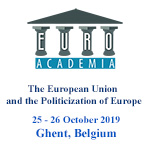Euroacademia Conferences
 Europe Inside-Out: Europe and Europeanness Exposed to Plural Observers (9th Edition) April 24 - 25, 2020
Europe Inside-Out: Europe and Europeanness Exposed to Plural Observers (9th Edition) April 24 - 25, 2020 Identities and Identifications: Politicized Uses of Collective Identities (9th Edition) June 12 - 13, 2020
Identities and Identifications: Politicized Uses of Collective Identities (9th Edition) June 12 - 13, 2020 8th Forum of Critical Studies: Asking Big Questions Again January 24 - 25, 2020
8th Forum of Critical Studies: Asking Big Questions Again January 24 - 25, 2020 Re-Inventing Eastern Europe (7th Edition) December 13 - 14, 2019
Re-Inventing Eastern Europe (7th Edition) December 13 - 14, 2019 The European Union and the Politicization of Europe (8th Edition) October 25 - 26, 2019
The European Union and the Politicization of Europe (8th Edition) October 25 - 26, 2019 Identities and Identifications: Politicized Uses of Collective Identities (8th Edition) June 28 - 29, 2019
Identities and Identifications: Politicized Uses of Collective Identities (8th Edition) June 28 - 29, 2019 The European Union and the Politicization of Europe (7th Edition) January 25 - 26, 2019
The European Union and the Politicization of Europe (7th Edition) January 25 - 26, 2019 7th Forum of Critical Studies: Asking Big Questions Again November 23 - 24, 2018
7th Forum of Critical Studies: Asking Big Questions Again November 23 - 24, 2018 Europe Inside-Out: Europe and Europeanness Exposed to Plural Observers (8th Edition) September 28 - 30, 2018
Europe Inside-Out: Europe and Europeanness Exposed to Plural Observers (8th Edition) September 28 - 30, 2018 Identities and Identifications: Politicized Uses of Collective Identities (7th Edition) June 14 - 15, 2018
Identities and Identifications: Politicized Uses of Collective Identities (7th Edition) June 14 - 15, 2018
Synchronicity: Contemporary Europe as a Temporal Project
-
-

-
Presentation speakers
- Emi Finkelstein, University of Pittsburgh, USA
- Download presentation
Abstract:
My proposed paper explores the function of exhibitionary and visual culture in constructing Central European identity. Considering Central Europe not as a defined geographic space but rather what historian Ole Bouman’s calls “a synchronized experience in time,” this paper broadly divides the history of the region into four periods following the end of World War II in order to understand how the region has—and continues to—relate to the West, to the globe and to itself. Using moments of historical rupture—1989, 1999, 2004, and 2013—it is possible to use work by individual artists to visualize the historic construct of Central Europe as a fluid, ever-evolving mode of thinking and identity-constructing that works both in and out of time with the European Union. Emphasizing the era from 1989 to the present, this paper considers the current period, here called “Europe as Agora: 2013-2025?” through the framework of the agora, a central public space for gathering, exchange, and producing exclusion. This framework is literalized in the recent exhibition “Hello World” (2018) at Berlin’s Hamburger Bahnhof, which presents a revision of the museum’s permanent collection, asking how a collection predominately committed to the art of the West can broaden its scope through non-Western artistic tendencies and a transcultural approach. The historic hall of the museum—transformed in both name and function into an agora—contained a number of works which gesture towards the political function of the space and hint at the parallels between the theoretical notion of the agora and the very real space of the European Union. Through a careful consideration of three of these works—made by Central European artists in different periods of Central Europe– this paper views “Hello World” as the producer of a temporal agora, a space for a new European synchronicity.
-
Related Presentations

Europeans by the Polls. What Voter Motivation Tells Us about EP Accountability
- Dorian Alt
- Erik Brandes
- David Nonhoff













